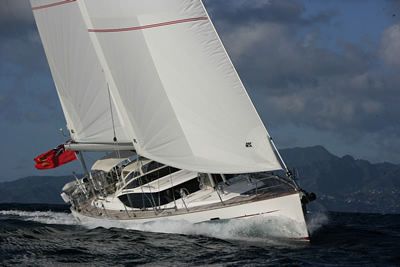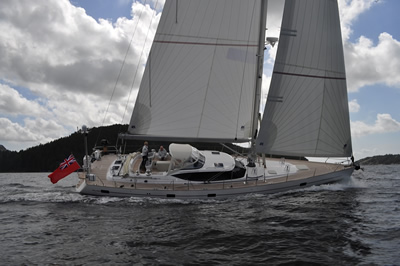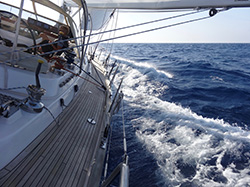The Headsail or Foresail
 |
The genoa appears 'de rigueur' for most sailors today. However, I prefer the working jib for the open sea, particularly when used in conjunction with the 'Simbo Rig'. It is more manageable, less prone to bury the bow in a seaway and provides substantially better forward vision.
For genoa aficionados though, a smaller foresail which can be set on an inner forestay to take over from the genoa in fresh to strong winds, is essential. Once a headsail particularly the genoa, has been furled by more than 30% of its original area, it not only becomes inefficient but increases healing angle and leeway.
In any event, I would advise replacing the snap-shackle securing the jib’s/genoa’s head to the foil’s sliding car/halyard, with a stout conventional shackle secured to the head of the foresail by a dyneema/spectra line. In the past I have been let down by metal fatigue in the swiveling snapshackle resulting in the headsail dropping into the sea.
The Simbo Rig will provide one with considerable ‘on wind’ benefits in re-trimming the foresails.
One can rest the upwind leeward jib on the downwind jib to re-route the jib sheet from the clew, from outside to inside the cap shroud for a closer sheeting angle and then on tightening up, the blanketed downwind jib/sheet can be re-routed. The converse applies on subsequently bearing away on a reach. Similarly, by resting the upwind jib on the downwind jib its loaded sheet car can be adjusted under sail without loss of drive or flogging sail. Having re-trimmed the weather jib, the downwind blanketed jib's sheet car can be easily adjusted. Very useful after shortening the sails in strong weather and on bearing off to a reach.
 |
When beating to weather and prior to coming about, release the upwind leeward jib/sheet to rest on its downwind twin, to leave just the downwind leeward jib/sheet to be released on coming through the wind. Once on the new tack, tighten the new downwind leeward jib/sheet which will capture its upwind leeward partner. The upwind leeward jib/sheet can then complete final sail trim.
Finally, should one need to heave-to for a prolonged period, it may be advisable to avoid undue wear on the weather sheets from the cap shroud, to re-route them from the clew to run inside the shroud.This can be expedited by re-running the downwind heave-to jib’s leeward sheet from the clew, to re-route it around the back of the weather cap shroud and re-secure to the sail. Following this, transfer the load of this downwind heave-to sail from the weather sheet to the re-routed leeward sheet with the assistance of the leeward mast winch. You can then slacken the weather sheet and re-route it from the clew to run inside the cap shroud and re-secure to the sail. Once this newly re-run weather jib sheet has been tightened to take back the jib’s load, its leeward sheet can be removed from the mast winch and clew and returned to its original set up.
 |
|---|
To re-route the upwind heave-to jib sheet inside the cap shroud. Ease its weather sheet to rest the jib on its downwind heave-to partner and re-run its leeward sheet from the clew to re-route it around the aft lower shroud and transfer the jib's load to the leeward sheet with the assistance of the leeward mast winch. This then permits you to slackened the weather jib sheet to re-run it from the clew inside the cap shroud and return to the sail. The jib’s load can then be transferred back to the weather sheet which enables the leeward sheet to be released from the mast winch and the clew and returned to its original set up.
The advent of the furling forestay of course, has been a boon to the short handed cruising sailor which when used in conjunction with the inmast furling mainsail provides control from the safety of the cockpit.